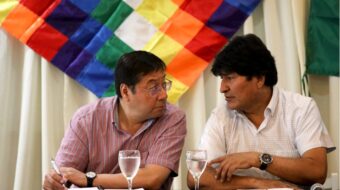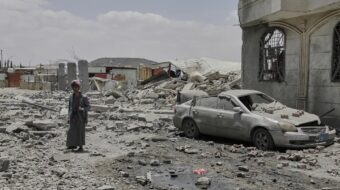Peru: Protests vs. state of emergency
Labor unions, agricultural producers’ associations, students and people’s organizations continued their vigorous protests this week against the nationwide 30-day state of emergency proclaimed by Peru’s government on May 27.
Several demonstrators have been killed, and many more injured, in attacks by police and soldiers wielding guns, teargas and water hoses.
Teachers, on strike since May 12, have been joined by court workers, health workers, farmers, students and others in protesting the neoliberal austerity policies of President Alejandro Toledo, a Stanford University graduate and former World Bank advisor whose approval rating has now sunk to 14 percent.
The General Federation of Workers of Peru (CGTP) called the state of emergency a “senseless measure” to block the justified protests of labor organizations, the National Council of Irrigation Users and others, and condemned the use of troops to maintain order. Stressing that the government is acting in the interests of right-wing business sectors linked to transnational capital, CGTP demanded an immediate end to the state of emergency and reopening of dialogue to resolve the country’s fundamental problems.
The Peruvian Communist Party said the emergency declaration “is an extreme and unnecessary measure, calculated by the government to impede the growing popular protest and ensure continuance of neoliberal policies until 2006.” Besides lifting the state of emergency, the PCP demanded “complete restoration of constitutional guarantees, unrestricted respect for the rights of workers and the people, and opening of dialogue to find solutions to the conflict.”
The World Federation of Trade Unions called on “all affiliates and friends” to express solidarity and give active support to the unions and organizations in struggle in Peru.
China: Public health system gets upgrade
The Health Ministry announced in Beijing last week that the central government will make major investments in the country’s health care system with emphasis on rural areas. The ministry said that in the next year it will establish a network of state and local Centers for Disease Control featuring well-trained and equipped mobile medical teams. Executive Vice Minister of Health Gao Qiang told journalists May 30 that China has allocated 4.6 billion yuan (about $575 million) for the CDCs. “We will not allow problems such as SARS to happen in the future,” Gao said.
In an interview with People’s Daily, Wang Lusheng, vice director of China National Health Economics Institute, said the country’s health care system, especially in rural areas, is quite backward in many respects such as grassroots medical facilities and medical insurance for farmers. Wang said that in the coming years the central government’s investment in the health system is likely to reach “dozens of billions of yuan.”
United Nations: Indigenous leaders demand compensation
Leaders of the world’s 350 million indigenous peoples gathered at the UN May 17 to discuss ways to protect their culture and environment. They demanded that transnational corporations accept legal responsibility for practices that destroy their people’s lands and lifestyles.
Participants told how oil, gas, lumber and mining projects by the transnationals, and sometimes by national governments, threaten their communities’ survival.
The World Bank has launched a $700,000 fund, “The Grants Facility for Indigenous People,” for projects on development themes recommended by the UN. But indigenous leaders called the fund “a cruel joke” because many World Bank officials are paid more than that each year, and the WB has loaned millions for projects that have destroyed indigenous communities and their environments. They demanded that the World Bank also address the issue of compensation for that devastation.
Australia: Detention center horrors continue
The Australian weekly newspaper The Guardian said last week that overcrowding and abusive conditions continue in detention centers around Australia, resulting in depression, self-harm and disastrous psychological problems among detainees.
The newspaper cited reports by the organization A Just Australia that some 1,125 people, including 97 children, are still being held in “extremely grim” conditions.
Some 450 detainees have been held for two years or more, and at least one for three years. About half of these are from Iran, and almost all say they would be at serious risk if forced to return. The Australian government has offered them a free flight and $2,000 to return voluntarily, and has threatened to return them forcibly unless they accept. But so far only two or three are said to have taken the offer.
Most centers are run by Australian Correctional Management, a subsidiary of the U.S. prison firm Wakenhutt. For a long time after it opened, the 1,500 inmates at the Woomera Detention Center were served by three toilets and five washing machines. Allegations of abuse were covered up and reports destroyed. Former staff and inmates said ACM had deliberately understaffed the center to maximize profits.
Compiled by Marilyn Bechtel, who can be reached at cpusainternat@mindspring.com









